Manchester Central Station was opened by the Cheshire Lines Committee (CLC) railway company on 1st July 1880. The CLC was a partnership of three railway companies that had come together in the 1860s, consisting of the Great Northern Railway (GNR), the Manchester, Sheffield & Lincolnshire Railway (MSLR) and the Midland Railway (MR).
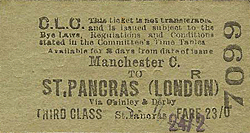 |
The CLC partners had all gained access to Manchester by the end of the 1860s through a variety of agreements that involved running over the lines of other companies. The MSLR shared a terminus station with the London & North Western Railway (LNWR) at Manchester London Road. The MSLR allowed the MR and the GNR to use their part of the station, but |
by the 1870s this situation was becoming a problem as London Road was increasingly congested. Outright hostility to the MR from the LNWR did not help matters.
With the opening of the CLC main line from Liverpool to Manchester in 1873, and its purpose-built terminus station at Liverpool Central on 2nd March 1874, the need for a station in central Manchester became even more pressing. The CLC had to run its trains from Liverpool and from its mid Cheshire line into Manchester London Road, which once again meant that there was a reliance on the LNWR.
| The CLC obtained an Act in June 1872, which granted them powers to extend their line from Liverpool into central Manchester and create a terminus station of their own. On 9th July 1877 a station that was known as Manchester Central opened on Windmill Street at the back of the city’s Free Trade Hall. This station was destined to have only a very short life as, at the time of |
 |
its opening, work was well under way on its permanent replacement.
The CLC chose its resident engineer Lewis Henry Moorsom, to build the permanent Manchester Central station, and work on the building commenced in 1875. Areas of notorious slum dwellings, which inspired the writings of Frederick Engels, had occupied the land on which the station was built. The city fathers were pleased to see the area cleared, although it is doubtful that any thought have been given to the individuals who lived there. Robert Neill & Sons, at a cost of £124,778, undertook the construction work.
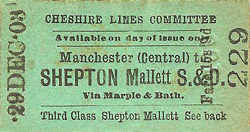 |
During the construction of the station the MR had found a way of accessing it from its main line to London St Pancras. In January 1876 the MSLR had given the MR notice to quit Manchester London Road station within three years. The MR took over a project that had been proposed by the Manchester South District Railway (MSDR) in 1873, obtained its own |
Act to build the line in July 1877, and started work on it in 1878. The line connected the CLC Liverpool - Manchester route just over a mile to the west of Manchester Central near Cornbrook, to the CLC Glazebrook - Woodley route via Stockport Tiviot Dale at Heaton Mersey, thus giving the MR a route into Central Station.
| When the station opened it consisted of a magnificent arched single-span roof, constructed by Andrew Handyside & Co. The dimensions of the arch at Manchester Central were 210 feet wide, 550 feet long and 90 feet high at the highest point. The frame itself weighed 2,400 tons and was covered using a combination of slate and glass. Underneath the roof |
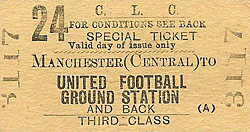 |
there were six platform faces, four of which were situated on two island platforms. The platforms were served by nine tracks, the extra lines being used by engines to run around their trains. The running lines and platforms were above street level, and beneath them were huge brick-built caverns that could be used to store goods. The lines exited the station via some very heavily engineered bridges and viaducts that carried the line down to Cornbrook where the Liverpool, Heaton Mersey and Chester lines separated.
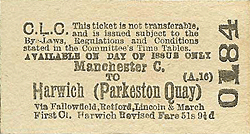 |
For the public the main entrance to the station was at the Windmill Street end. At the time of opening wooden buildings provided all of the usual facilities including the main booking office. These facilities were meant to be a temporary measure, as it was intended that a hotel to be constructed would form a grand frontage to the station. A large clock face was |
provided on the inside and on the outside of the station.
When the permanent station opened, its temporary predecessor closed to passengers and was developed as a goods station.
| From the opening of Manchester Central trains ran to Liverpool via the CLC main line, to Stockport and beyond via the South District line, and to Northwich and Chester via the CLC’s mid Cheshire route. From Monday 2nd August 1880 the MR began to run express services between Manchester Central and Buxton, Derby and London St Pancras. From October |
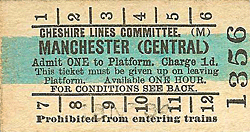 |
1891 the GNR introduced express trains between Manchester Central and London Kings Cross. They had opened a new line that ran from Fairfield, on the MSLR main line between Manchester and Sheffield, to Chorlton-cum-Hardy on the South District Line, giving them access to Central Station. At the same time a local all-stations service was introduced between Manchester Central and Guide Bridge.
On 1st July 1897 the MSLR changed its name to the Great Central Railway (GCR), and a couple of years later, on 15th March 1899, they opened their London Extension Railway to London Marylebone. From this date trains also ran between the new GCR London terminus and Manchester Central.
 |
In 1896 the MR purchased land at the front of Manchester Central station on which to build a hotel. By this time, however, it was decided that the hotel would not be built onto the front of the station as originally envisaged; instead it was built a short distance away on the other side of Windmill Street. The hotel was designed by the MR’s architect Charles Trubshaw assisted by William Towle. It was a magnificent structure that was the height of luxury. It opened on 5th September 1903 having taken four years to build. A covered walkway was built between the station entrance and the hotel so that passengers could be protected from wet weather. The station’s so-called temporary wooden buildings were destined to remain in place.
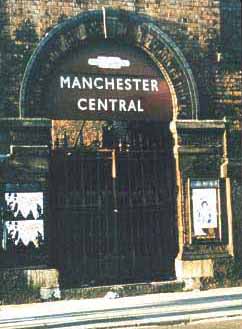 |
By the time the hotel had opened, passengers were able to travel between Manchester Central and Buxton, Chester Northgate, Derby, Hull, Liverpool Central, London Kings Cross, London Marylebone, London St Pancras, Nottingham and Southport Lord Street. Local services radiated out to the south Manchester suburbs and to such towns as Warrington and Wigan. Because of the intense levels of traffic the station had to be extended.
In 1906 extra platforms were built outside the overall roof on the south east side of the station. The platforms were constructed from wood and were provided with awnings to protect passengers from the elements. Three platform faces were created in all, one of which, platform 7, was effectively a bay at the end of platform six. The new platforms were numbered seven, eight and nine. |
| During the early years of the 20th century the MR made substantial investments to speed up its services from Manchester to London in direct competition with the LNWR. With the construction of a new direct line between Heaton Mersey and New Mills opening in 1902, MR express trains were reaching London from Manchester Central in 3 hours and 40 minutes, which |
 |
which was only 10 minutes slower than the LNWR. The MR also provided levels of comfort, including the introduction of Pullman Coaches, not previously seen in Britain.
In 1923 the GCR and the GNR became part of the London & North Eastern Railway (LNER) while the MR became part of the London Midland & Scottish Railway (LMS). The CLC remained independent, but it now had only two partners, the LMS and the LNER; the LNER had two thirds of the shares and the LMS one third.
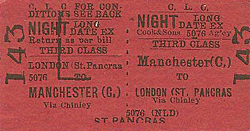 |
After 1923 competition between the former LNWR and MR routes was no longer an issue as they both belonged to the LMS. Express services out of Manchester Central did not suffer, though, because the LMS considered the MR route to be important as it took the strain off the former LNWR line. During the 1930s two of the services between London St Pancras |
and Manchester Central were named trains: the ‘Peak Express’ and the ‘Palatine’. The Peak Express covered the journey in 3 hours and 35 minutes.
In 1935 the signalling at Manchester Central was modernised using the latest technology. Colour light signals replaced semaphores that had served the station since its earliest days.
During the Second World War passenger services were reduced both in number and in speed. At the end of hostilities it took many years for timings to reach anything like their pre-war levels.
| From 1st January 1948 Manchester Central became part of the nationalised British Railways (London Midland Region) and the CLC was no more. In the early 1950s service patterns from Manchester Central were fairly familiar, but competition from road was having an effect on some of the more local services. The South District services which at this time were |
 |
running between Manchester Central and Stockport Tiviot Dale or Cheadle Heath, and which had once built up to a ten minute frequency, were down to twenty-three per weekday by 1954. In 1952 the Southport Lord Street service was cut back to Aintree, and in July 1958 the Guide Bridge service ended.
A regular service between Liverpool Central and Manchester Central continued to run, and from 1958 Manchester Central found itself handling an increase in express services to the south. This was because British Railways had decided to electrify the former LNWR route from Manchester London Road, which was renamed Manchester Piccadilly, to London Euston. As the electrification work would cause delays it was decided to concentrate services at Manchester Central.
 |
From 4th July 1960 a new train that had been developed by British Railways, a diesel Pullman, which became known as the ‘Blue Pullman’, began to operate between Manchester Central and London St Pancras. The train was both modern and luxurious, completed the journey in 3 hours and 13 minutes, and proved very popular with business travellers. Sleeping |
car services were also concentrated into Manchester Central at this time, but they were routed over the former GCR main line to London Marylebone. Also in 1960 new four-car Diesel Multiple Units (DMUs) were introduced onto the Liverpool service. In 1961 DMUs also started to operate on the South District line and on services to Chester and Buxton. However, despite the modernisation, steam-hauled services could still be seen at Manchester Central during this period.
| The years between 1960 and 1966 were very busy at Manchester Central, but they were to prove to be a swansong. In April 1966 electrification of the LNWR route was completed and services were concentrated onto that route. The Blue Pullman ceased to operate in 1966, and on 1st January 1967 the South District service ended. As early as September 1966 British |
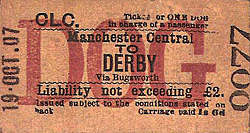 |
British Rail, as it had then become known, was considering how they might close Manchester Central and divert the remaining services. A target date for closure was eventually set for June 1968 with an estimated cost of £539,000. The costs were associated with junction remodelling that was needed to allow Liverpool and Chester trains to run towards Piccadilly.
From the 1st January 1968 express services were diverted to run into Manchester Piccadilly. The last express services had run between Central Station and Nottingham and London St Pancras. From this date the only trains that served Manchester Central were the Liverpool and the Chester services along with a Sundays-only service that ran between Liverpool Lime Street and Sheffield Midland.
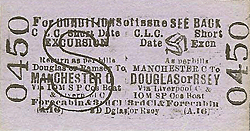 |
The intended closure date of June 1968 was not met, and a new date was set for 5th May 1969. The last trains ran out of the station on Saturday 3rd May 1969. Following its closure the station was sold to the NCP Car Parking empire in 1972. It slowly decayed, acting not only as a symbol of the decline of Britain’s railways but also of the country’s northern industrial towns. It |
was purchased by the Greater Manchester Council in 1978. Thankfully, as Manchester began to resurrect itself from its decline in the early 1980s, the city officials focussed their attention on the station. In 1983 it was given Grade II* Listed status, then work began on converting it to an exhibition hall. On 7th March 1986 it re-opened to the public as the GMEX exhibition hall. For over 20 years the GMEX hosted shows, exhibitions and concerts.
In January 2007 the venue was renamed as Manchester Central, once again taking on its historic name.
Other web sites:Closed South Manchester Railways, The Hyde & Peak Railtour, Bike rides around the Greater Manchester area & Levenshulme then and now.
Further reading. The Fallowfield Line, EM Johnson 2000 Foxline Pub.ISBN187011969X
Tickets from Michael Stewart, route map drawn by Alan Young
To see other stations between Manchester Central & Cheadle Heath click on the station name: Manchester Central, Chorlton-cum-Hardy, Withington & West Didsbury, Didsbury, Heaton Mersey, Cheadle Heath
To see the other
stations on the Woodley - Glazebrook line click on the station
name: Stockport Tiviot Dale, Stockport Portwood, Cheadle North, Northenden, Baguley, West Timperley, Partington (1st), Partington (2nd), Cadishead (1st) & Cadishead (2nd) |

central_old9.jpg)
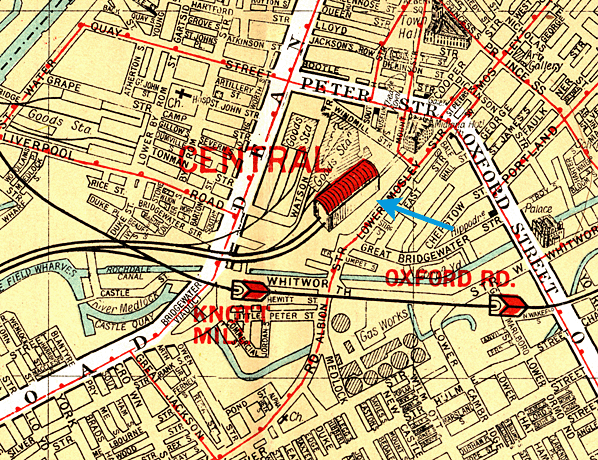
central_old12.jpg)
central_old8.jpg)
central_old30.jpg)
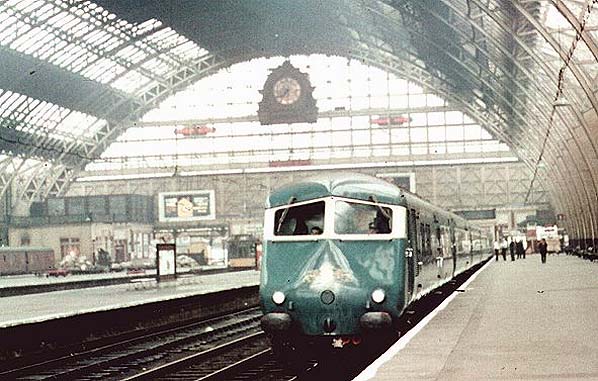 The
'Blue
Pullman' at Manchester Central the 1960's
The
'Blue
Pullman' at Manchester Central the 1960'scentral_old23.jpg)
central22.jpg) Manchester central seen from the trackbed of the approach lines in April 1977. The picture clearly illustrates the station's layout. The platform face nearest to the photographer is one of the platforms that was added in the early 20th century to the outside of the trainshed.
Manchester central seen from the trackbed of the approach lines in April 1977. The picture clearly illustrates the station's layout. The platform face nearest to the photographer is one of the platforms that was added in the early 20th century to the outside of the trainshed.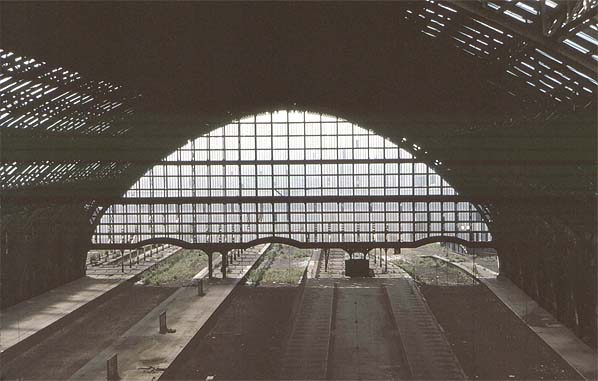
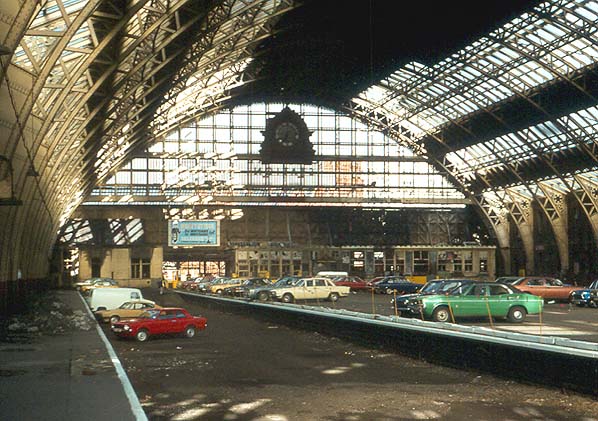 Manchester
Central Station was used as a car park in 1980
Manchester
Central Station was used as a car park in 1980central.jpg)
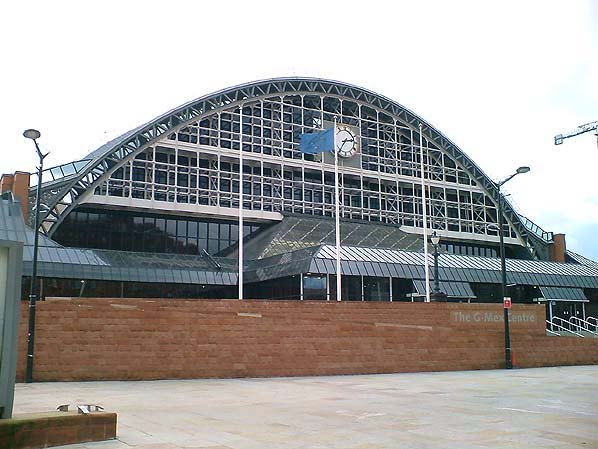
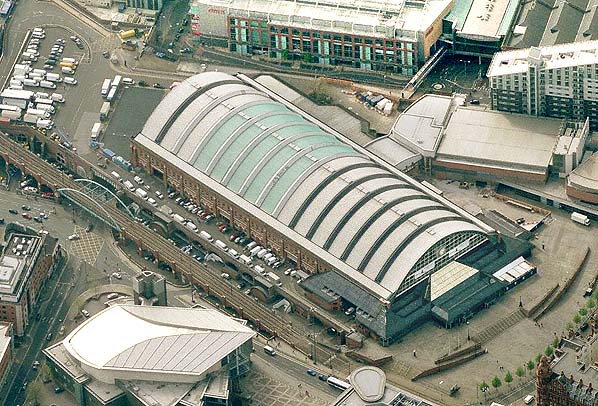


















 Home Page
Home Page